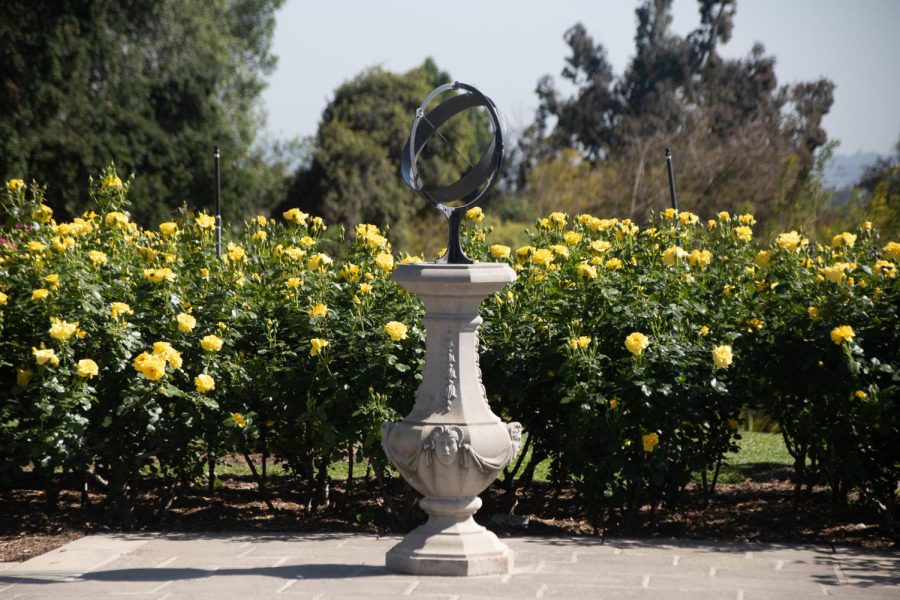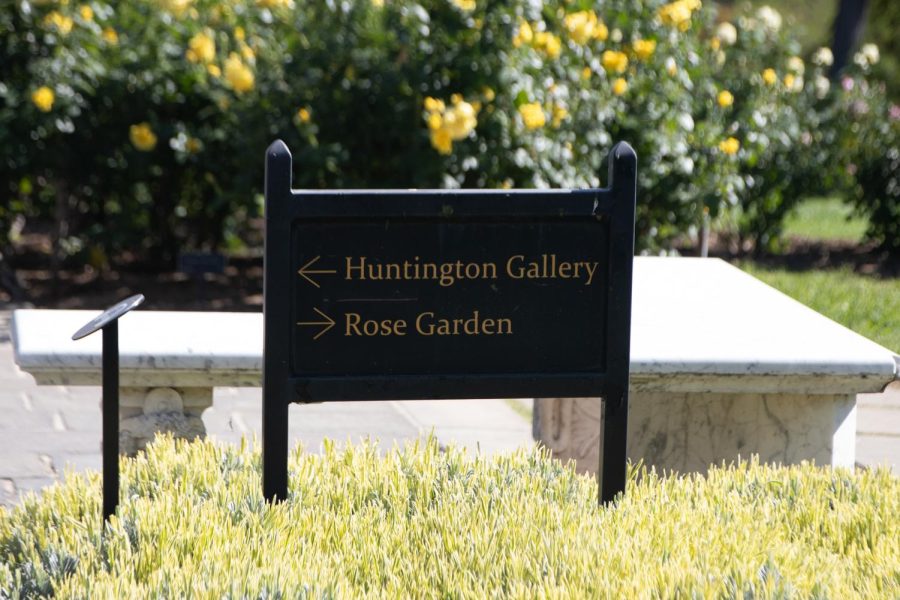The Huntington nurtures botanical havens, showcases rare artifacts
A metal ring statue stands in the Rose Garden at the Huntington. The garden was initially created in 1908 for the private use of Henry and Arabella Huntington and later opened to the public in 1928.
April 9, 2022
Harker Aquila visited The Huntington Library, Art Museum and Botanical Gardens on Wednesday before attending the JEA/NSPA National High School Journalism Convention that began Thursday.
LOS ANGELES – Amidst a long row of magnificent white arches, tiny pink flowers creep up the sides of poles, filling the air with a sweet fragrance. Outside the archway along the shaded path, the first signs of spring blossom in bright flowers and the serenity of surrounding flora and fauna. Just a few walkways down, the next garden features traditional Japanese architecture, stone ponds and blooming cherry blossom trees – an isolated cultural haven found right in Los Angeles.
The Huntington Library, Art Museum and Botanical Gardens, located in San Marino, Calif., is a collection of libraries and museums surrounded by 16 themed gardens, including the Rose Garden and the Shakespeare Garden. Founded by Henry and Arabella Huntington in 1919, the 55,000-square-foot Art Gallery previously served as the pair’s home. Both Huntingtons shared a passion for collecting all sorts of items — art, books and plants in particular. As their collection grew, so did the establishment.
Following the couple’s deaths in 1924 and 1927, individuals sponsored the addition of botanical centers, art galleries and research centers. Now, the property spans 207 acres, 130 of which are open to visitors. In 2015, The Huntington added a 52,000-square-foot visitor center with cafes, gift shop and educational classrooms.
Viola, a waitress who began working at the 1919 Cafe in the visitor center in November 2021, appreciated how The Huntington offered her the unique opportunity to experience multiple cultures in a unified location. In particular, she enjoyed learning from The Huntington’s non-Western exhibits, including the Chinese and Japanese gardens.
“I like being at The Huntington in general, and I was looking for a job,” Viola said. “I thought it would be nice because I can go through different environments from around the world in a day. I really love the Japanese Garden — it’s such a beautiful thing.”
The Huntington Visitor Center also includes The Huntington Store, a gift shop that consists of eight themed rooms with books, decor and more – all related to Huntington’s library, art and botanical experiences. Welcoming over 800,000 visitors every year, the gift store proves to be one of Huntington’s most popular attractions. Masha Mesherya, who visited The Huntington Store on Wednesday, noted that the multitude of diverse gardens convinced her to visit for the second time.
“I visited in January and it was just the most beautiful I’d seen in a long time, so I decided to bring my mom for a visit,” Masha said. “Everything is really beautiful — the museums are pretty, there’s a lot of walking to do and a lot to see. Each garden has its own thing, but my favorite is probably the Japanese garden.”
In January 2022, Huntington President Karen R. Lawrence delivered a public statement on Huntington’s official website regarding COVID-19 pandemic updates. After facing significant challenges due to the pandemic, such as having to postpone their “Made in L.A. 2020: a version” exhibition, which was in collaboration with the Hammer Museum, by 10 months.
“There was much promise for vaccines [in 2021], yet uncertainty as to when they would become widely available,” Lawrence said. “Nevertheless, we persevered. As we were greeted by countless individuals thanking us for keeping the gardens open, we realized that we are a critical respite for many during a very challenging time. Together, even in the face of daunting times, we’re not only making it through—we’re thriving!”


















![“[Building nerf blasters] became this outlet of creativity for me that hasn't been matched by anything else. The process [of] making a build complete to your desire is such a painstakingly difficult process, but I've had to learn from [the skills needed from] soldering to proper painting. There's so many different options for everything, if you think about it, it exists. The best part is [that] if it doesn't exist, you can build it yourself," Ishaan Parate said.](https://harkeraquila.com/wp-content/uploads/2022/08/DSC_8149-900x604.jpg)




![“When I came into high school, I was ready to be a follower. But DECA was a game changer for me. It helped me overcome my fear of public speaking, and it's played such a major role in who I've become today. To be able to successfully lead a chapter of 150 students, an officer team and be one of the upperclassmen I once really admired is something I'm [really] proud of,” Anvitha Tummala ('21) said.](https://harkeraquila.com/wp-content/uploads/2021/07/Screen-Shot-2021-07-25-at-9.50.05-AM-900x594.png)







![“I think getting up in the morning and having a sense of purpose [is exciting]. I think without a certain amount of drive, life is kind of obsolete and mundane, and I think having that every single day is what makes each day unique and kind of makes life exciting,” Neymika Jain (12) said.](https://harkeraquila.com/wp-content/uploads/2017/06/Screen-Shot-2017-06-03-at-4.54.16-PM.png)








![“My slogan is ‘slow feet, don’t eat, and I’m hungry.’ You need to run fast to get where you are–you aren't going to get those championships if you aren't fast,” Angel Cervantes (12) said. “I want to do well in school on my tests and in track and win championships for my team. I live by that, [and] I can do that anywhere: in the classroom or on the field.”](https://harkeraquila.com/wp-content/uploads/2018/06/DSC5146-900x601.jpg)
![“[Volleyball has] taught me how to fall correctly, and another thing it taught is that you don’t have to be the best at something to be good at it. If you just hit the ball in a smart way, then it still scores points and you’re good at it. You could be a background player and still make a much bigger impact on the team than you would think,” Anya Gert (’20) said.](https://harkeraquila.com/wp-content/uploads/2020/06/AnnaGert_JinTuan_HoHPhotoEdited-600x900.jpeg)

![“I'm not nearly there yet, but [my confidence has] definitely been getting better since I was pretty shy and timid coming into Harker my freshman year. I know that there's a lot of people that are really confident in what they do, and I really admire them. Everyone's so driven and that has really pushed me to kind of try to find my own place in high school and be more confident,” Alyssa Huang (’20) said.](https://harkeraquila.com/wp-content/uploads/2020/06/AlyssaHuang_EmilyChen_HoHPhoto-900x749.jpeg)









